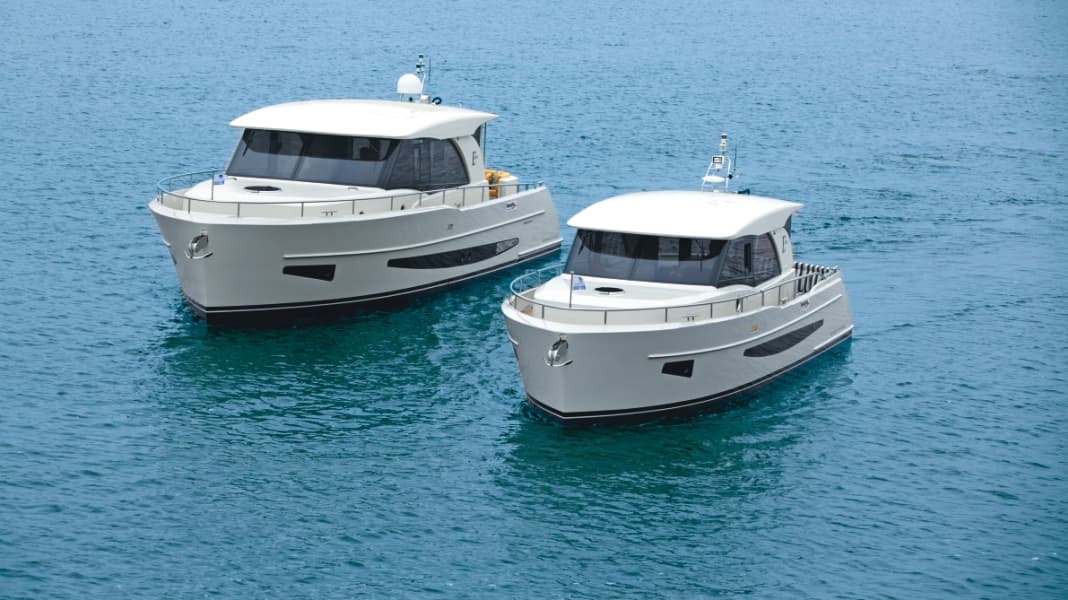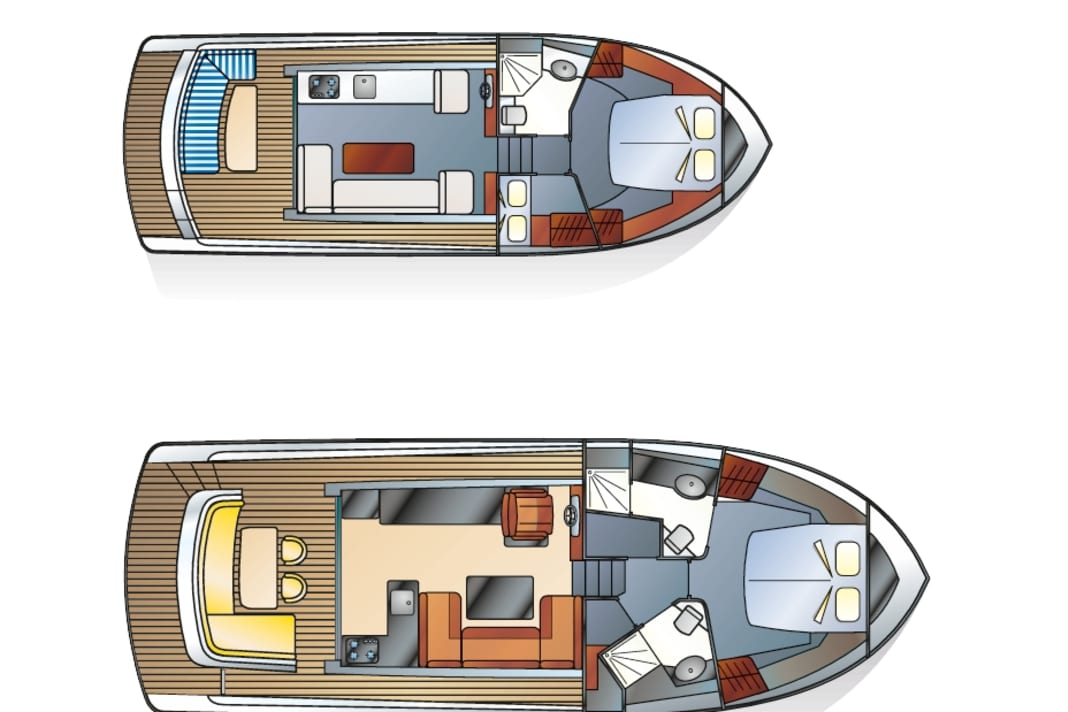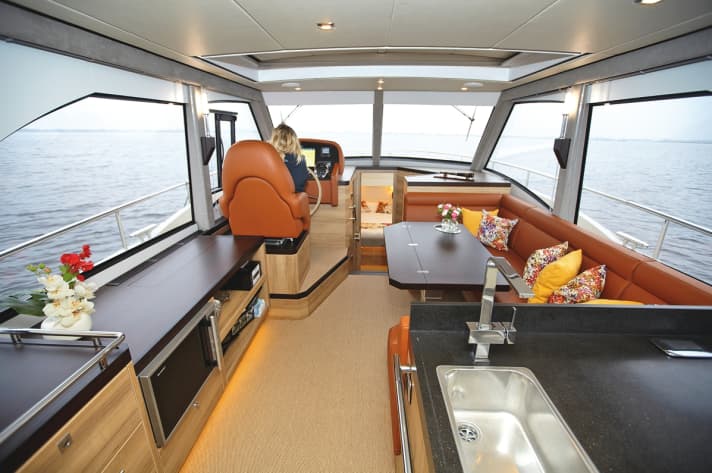Boarncruiser Elegance 1100 and 1300 - Boarncruiser's new sedan in a double test
Peter Laessig
· 28.02.2016

De Boarnstream is one of the finest shipyards in the Netherlands, where many a boat with the "wow factor" has been launched. Henk Hokwerda founded the shipyard in 1964, the same year that the Beatles began to conquer the world. The Beatles are now history, but De Boarnstream is being continued in the second generation by Henk's daughter Wies, while Henk still keeps an eye on things in the background as grand seigneur.
Even as a pensioner, he can't help but devote himself to designing new boats. In 2013, for exampleprevious models Retro, Classic and New Lineanother line has been added,Boarncruiser Elegance. It comprises a series of five models with and without flybridge, which will be available in steel or aluminium. The Elegance 1100 marks the beginning and the Elegance 1700 marks the end for the time being.






The boats are available as pure displacement models or, from the Elegance 1200 upwards, with more steam in the boiler, i.e.more powerful engines. Elegance boats will then be used asSemi-glider with shaft or IPS drives plough through the water more quickly. Instead of the steel superstructure, the "fast ones" have aAluminiumbut the fuselage remains inSteel.
Depending on the speed or safety requirements, one or two motors are installed. The numbers, such as 1100, stand for the length. And if there is no Fly, the boats are called sedans. Sedans used to refer to luxurious cars in which you could travel in comfort.
With the new line, De Boarnstream is following the trend of the times, in which the cockpit and saloon are on one level and glass fronts on all sides are intended to convey a feeling of space and sea(h)vour. Nomen est Omen, the Boarncruiser Elegance radiates power and beauty.
We can check how strong the radiance is and whether there are also shadows because of all the light by looking at two boats, Elegance 1100 and 1300 in the Sedan version. They are built from top to keel in traditional steel construction, the hull shape is called "simple folding frame".
As is customary in the Netherlands, external companies build, blast and paint the steel hulls outside the shipyard. Everything is then sent to Boarncruiser, where external furniture builders and in-house technicians take care of the rest. PU foam is sprayed onto the interior hull walls from the waterline upwards and sometimes under the ceilings to insulate engine noise and noise from the outside. Although this costs a little more than simple rock wool and doesn't look as smooth, it insulates perfectly.
You would expect quality from Boarncruiser, and at first glance, the test duo is just right. However, if you look closely, the little things here and there add up quite conspicuously. The fact that the shipyard outsources the work to subcontractors, as is usual in the industry, is acceptable as long as the quality is right. In this case, both test boats did not convince us and left the impression that the necessary finishing touches were missing.
While the standard engine in the Elegance 1100 is a 75 hp diesel under the saloon floor, a 150 hp diesel is installed in the same place in the 1300. The engine manufacturer is Volvo Penta and comes from Sweden. Our test boats, on the other hand, are powered by a D3-110 in the smaller and a D4-180 in the larger. The 110 hp diesel in the Elegance 1100 is slowed down at 2800 rpm by a propeller that is too steep; 3000 rpm is permitted. On the other hand, the 180 hp D4 in the Elegance 1300 reaches its permitted maximum speed of 2800 rpm.

This puts all the figures for the Elegance 1100 into perspective in terms of speed and range. In other words, we measured a maximum speed of 8.3 knots and calculated ranges of 900 nm at slow speed and 150 nm at full throttle, plus a 15% reserve in each case. For the Elegance 1300, the values are 9.2 kn top speed and, depending on the position of the throttle, ranges of between 2500 nm and 240 nm, plus reserves. For both boats, we referred to the engine manufacturer's consumption data and took into account a tank volume of 360 litres for the Elegance 1100 and 1000 litres for the Elegance 1300.
The Prinses-Margriet Canal in North Friesland serves as our test area. This is one reason why we are unable to make any statements on the subject of rough water behaviour and how the boats behave in waves. We have to rely on Henk Hokwerda, who assures us that his boats have no problems with this.
We have no problems manoeuvring, and both boats can easily moor astern to port thanks to the bow thruster plus optional stern thruster and right-turning propellers. The fact that this is the "shoal side" when mooring is also documented by the port railing passages on both boats and additionally on the 1300 through the door in the port bulwark. At full speed, the full circles of both boats measure up to three boat lengths and tilt slightly outwards, as is typical of displacement boats.
To our surprise, there are virtually no centrifugal forces and you can safely leave everything on tables and furniture. Travelling in a straight line is also more than satisfactory: you can take your hands off the rudder for a while without worrying and let the boat follow its chosen course.
If the two boats are lying side by side in the harbour and you approach them from aft, the Elegance 1100 appears to be a "narrow shirt" compared to the 1300. No wonder, as the Elegance 1300 measures 4.55 m in width while the 1100 is almost a metre narrower. If you multiply the length by the width, the Elegance 1300 has a theoretical floor area of around 60 m² and the 1100 39 m². This is more than noticeable, which is why you will find two cabins plus bathroom with shower and WC below deck on the Elegance 1100 and three cabins and two bathrooms in the same place on the Elegance 1300. And, on the Elegance 1300 there is a huge storage space hidden under the cockpit floor, which could easily serve as another cabin (crew cabin). The storage space on the 1100 cannot quite keep up with this in the same place, but still deserves the attribute "very large".
On both boats, the galley is part of the saloon and is equipped with everything you need on board. Food is served on the saloon tables and there is an L-shaped bench seat on the Elegance 1100 and a U-shaped bench seat on the 1300. On both test boats, the saloon table and couch can be converted into emergency berths. The driving positions on both boats fit and are equipped with everything you need. There is nothing else to criticise in terms of the basic equipment on either boat.

Conclusion
Both boats are comfortable to live and travel on, although the Elegance 1300, with its more generous dimensions, has a lot more space and comfort to offer. However, this is offset by the almost 200,000 euro higher price. In terms of workmanship, the test duo shows details that do not convince us. The driving and manoeuvring characteristics are good and typical of a steel displacement vehicle.

